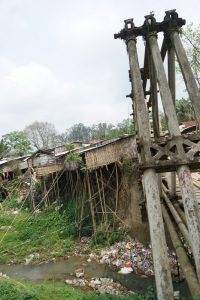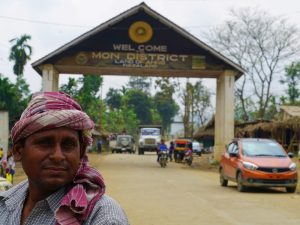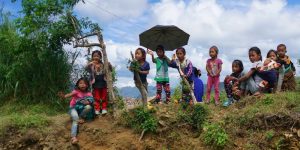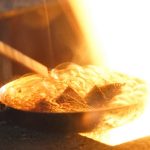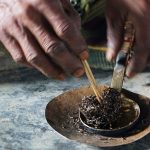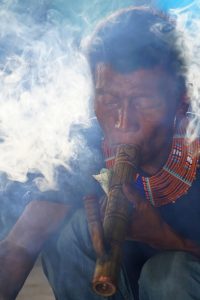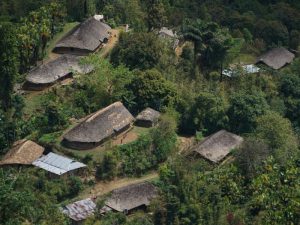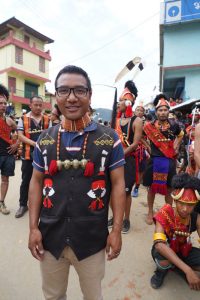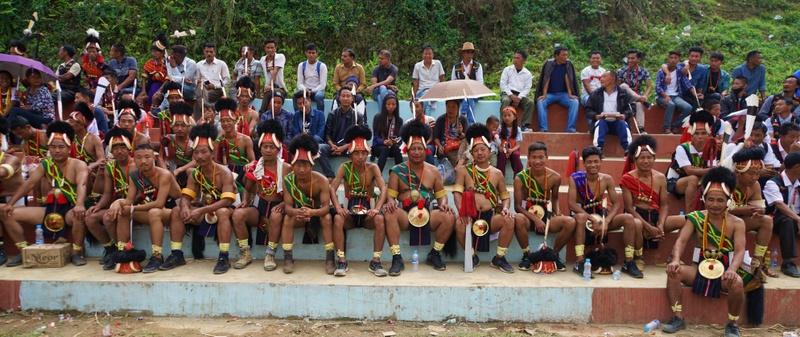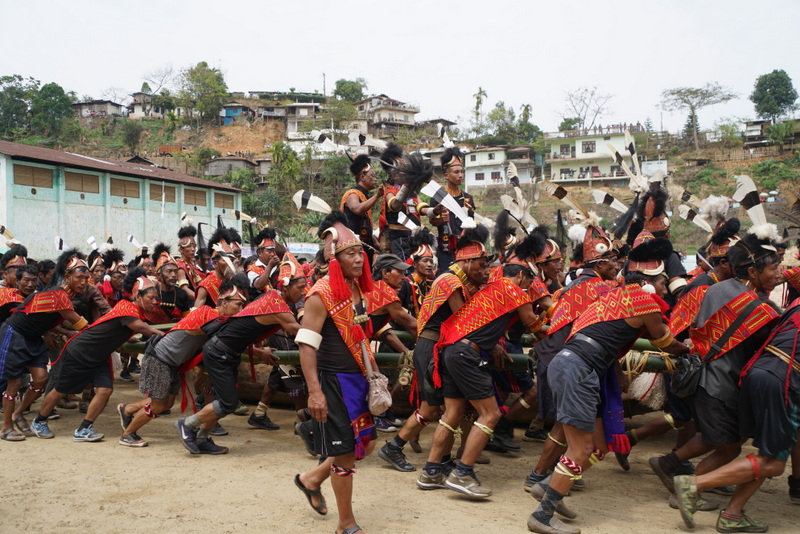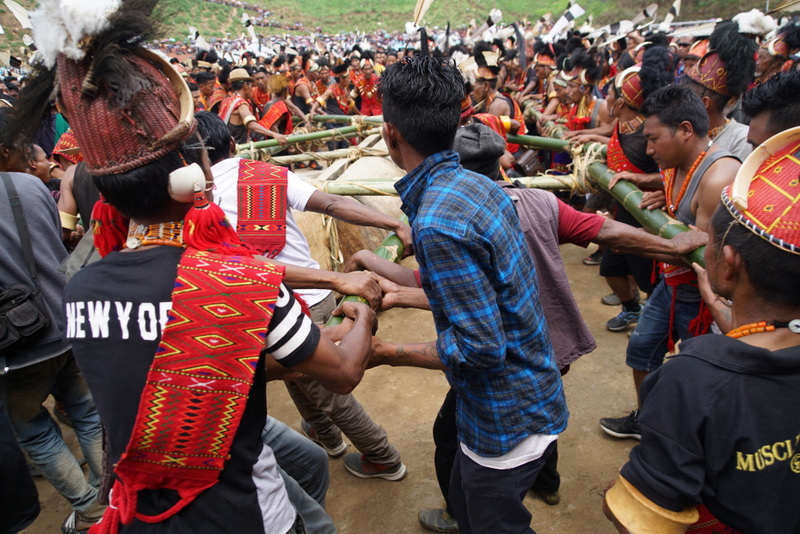April 1 – 5 Sivasagar & Aoleang Festival, Mon
Day 9 Monday: Majuli Island – Brahmaputra River – Sivasagar (60km)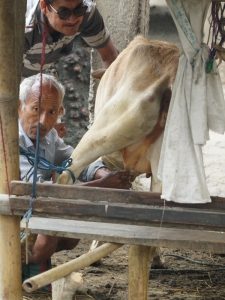
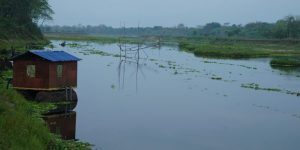 The weather had improved. Though it was drizzling when we got up around 5:30 am, it was dry enough for a morning walk at 6 am. We followed Navin and had a short walk along a river near the resort. We watched waterfowl and birds.
The weather had improved. Though it was drizzling when we got up around 5:30 am, it was dry enough for a morning walk at 6 am. We followed Navin and had a short walk along a river near the resort. We watched waterfowl and birds.
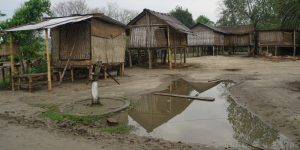 Then we walked through a large village. The air was fresh. The villagers looked healthy and active. An elderly man was milking his cow and a man took the milk away in his own container. Some men were working in the fields. Children were waving at us.
Then we walked through a large village. The air was fresh. The villagers looked healthy and active. An elderly man was milking his cow and a man took the milk away in his own container. Some men were working in the fields. Children were waving at us.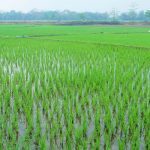
Susan who buys and sells fabrics is always interested in looking at tribal weaving art. Navin us to a weaver and three members bought four pieces of work from her.
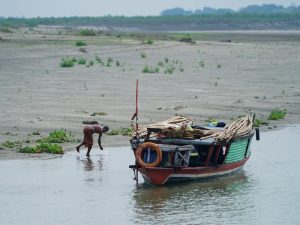 We returned to the resort hotel for breakfast. As we had to take the 8:30 am ferry, we left for the pier at 7:45 am. Everything went well: we had a smooth crossing in a larger boat and landed at Nimati Ghat around 10 am.
We returned to the resort hotel for breakfast. As we had to take the 8:30 am ferry, we left for the pier at 7:45 am. Everything went well: we had a smooth crossing in a larger boat and landed at Nimati Ghat around 10 am.
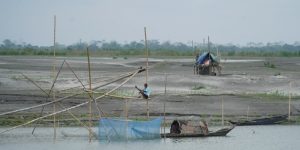 We were met by our two drivers. By midday, we arrived in Sivasagar, located 360 km northeast of Guwahiti. The Shans, who came from Thailand through northern Myanmar in the early 13th Century, had ruled for 600 years. Formerly known as Rangur, Sivasagar was the capital of the Ahom Kingdom from 1699 to 1788. The kingdom fell to the Burmese in 1819 and to the British in 1825.
We were met by our two drivers. By midday, we arrived in Sivasagar, located 360 km northeast of Guwahiti. The Shans, who came from Thailand through northern Myanmar in the early 13th Century, had ruled for 600 years. Formerly known as Rangur, Sivasagar was the capital of the Ahom Kingdom from 1699 to 1788. The kingdom fell to the Burmese in 1819 and to the British in 1825.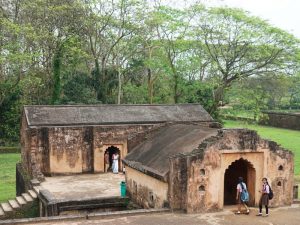
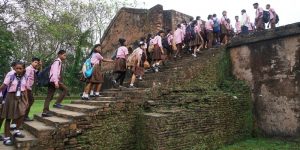 Possibly owing to the coughing syrup, I slept all the way to Sivasagar. On arrival, we went to the ruins of a brick palace Talatal Ghar which was one of the grandest examples of Ahom architecture and the largest of all Ahom monuments. Once a seven-storeyed structure with underground floors and several secret tunnels including one which is said to be 16km-long to the old capital, visitors today can only visit the remains of the second and third floors.
Possibly owing to the coughing syrup, I slept all the way to Sivasagar. On arrival, we went to the ruins of a brick palace Talatal Ghar which was one of the grandest examples of Ahom architecture and the largest of all Ahom monuments. Once a seven-storeyed structure with underground floors and several secret tunnels including one which is said to be 16km-long to the old capital, visitors today can only visit the remains of the second and third floors.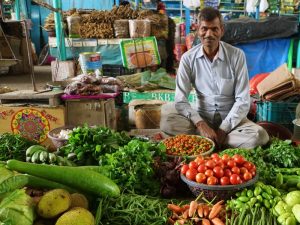
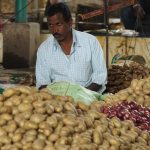 It was after 2 pm when we checked in Hotel Shiva Palace. We had two hours for lunch and rest. Lesley and I always prefer local food. We ventured out and had lunch with rice and fish for R100. Great! We also went to a local market. All the stall keepers are men.
It was after 2 pm when we checked in Hotel Shiva Palace. We had two hours for lunch and rest. Lesley and I always prefer local food. We ventured out and had lunch with rice and fish for R100. Great! We also went to a local market. All the stall keepers are men.
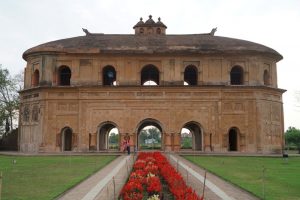 At 4 pm, we took tuk tuk to the Rang Ghar, a double-storeyed royal sports pavilion.
At 4 pm, we took tuk tuk to the Rang Ghar, a double-storeyed royal sports pavilion.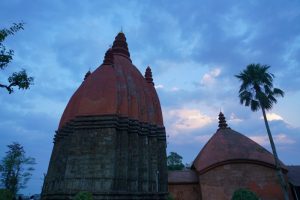
Our last stop was the Shiva Dol (Temple) built in the 18th century during the Ahom Dynasty. It is the tallest temple at 31.6 m in Northeast India. The temple has a massive dome on top made of pure gold which is called the Kosoloi. It is one of the most famous pilgrimage sites in India.
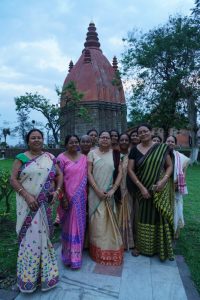 I watched many pilgrims entering the temple. I did not know whether non-Hindu could enter the temple or not. Soon a local signalled me to enter. Its pillars and walls have engravings in the form of various Hindu gods and goddesses.
I watched many pilgrims entering the temple. I did not know whether non-Hindu could enter the temple or not. Soon a local signalled me to enter. Its pillars and walls have engravings in the form of various Hindu gods and goddesses.
I watched with curiosity a man cracking a coconut and pouring the milk in a large stone pool on the ground. A lady was kneeling and placing flowers in pool: she placed the blessed water/liquid on her forehead.
The Devi Dol (1734) dedicated to Goddess Durga is next to Shiva Dol. I went inside. The temple is 18.2-metre high and the ‘bolisthal’, the most sacred part of the temple, is reserved for the main rituals.
In front of the temples is the Joysagar Lake, the largest man-made tank in India excavated in 45 days in 1697 by Swargadeo Rudra Singha in memory of his mother.
We walked back to the hotel through the bustling city centre. In the evening, I joined the group to eat at the Sky Chef Restaurant though I was not hungry. I ordered a fish curry which price was R200 on the menu. When I got the bill, it said R300. Anyway, I paid since it was not a lot of money. I must say it is not value for money at all: the fish was fried and tasteless as compared the fish I had in the street food stall for R100.
Day 10 Tuesday: Sivasagar, Assam – Mon, Nagaland (120 km)
Today we headed to Mon in the state of Nagaland. There are expansive tea plantations along the road in Assam. But once we entered Nagaland, the landscape began to change and we drove along winding roads. Unfortunately, the first Nagaland town we stopped was filthy with litters dumped in the river and found along the road. The people look like those from hills tribes in China, northern Thailand, Myanmar and Laos.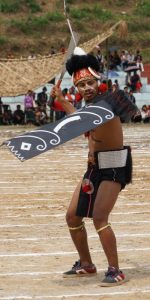
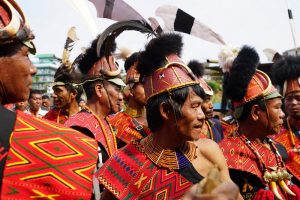 Nagaland is one of the smallest states of India with an area of 16,579 km2 and a population of about 2 million. The state is mostly mountainous except those areas bordering Assam valley. Agriculture is the most important economic activity. Other significant economic activity includes forestry, tourism, insurance and miscellaneous cottage industries. The state is inhabited by 16 tribes each with its own distinct customs, language and dress. It is one of three states in India where the population is mostly Christian. Kohima is the state capital.
Nagaland is one of the smallest states of India with an area of 16,579 km2 and a population of about 2 million. The state is mostly mountainous except those areas bordering Assam valley. Agriculture is the most important economic activity. Other significant economic activity includes forestry, tourism, insurance and miscellaneous cottage industries. The state is inhabited by 16 tribes each with its own distinct customs, language and dress. It is one of three states in India where the population is mostly Christian. Kohima is the state capital.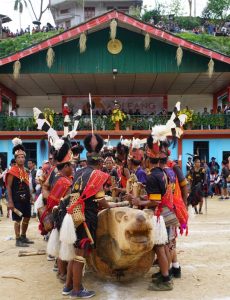
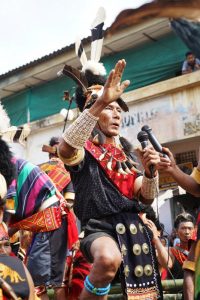 Nagaland is known in India as the land of festivals. The diversity of people and tribes creates a year-long atmosphere of celebrations. Each major tribe has its festival. The government of Nagaland has successfully launched since 2000 the Hornbill Festival held between 1 and 10 December.
Nagaland is known in India as the land of festivals. The diversity of people and tribes creates a year-long atmosphere of celebrations. Each major tribe has its festival. The government of Nagaland has successfully launched since 2000 the Hornbill Festival held between 1 and 10 December.
Mon is the Regional capital of the Konyak tribe. At 897m above sea level, Mon is one of the most mystic places in Nagaland and boasts a rich tribal heritage. The Konyak tribe hosts a colourful Aoleang Festival in April.
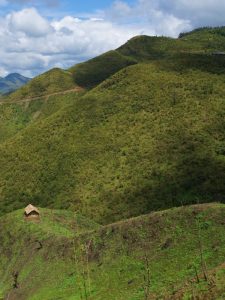 Mon district is a nature lovers’ paradise offering some of the best views of the Assam plains. The district is also known for Headhunting as it was practised in historic times.
Mon district is a nature lovers’ paradise offering some of the best views of the Assam plains. The district is also known for Headhunting as it was practised in historic times.
We arrived at the Teihpha Cottage (Homestay) around 1 pm and met a local guide from Mon. At 2:30 pm, we set off to the Hongphoi Village to meet one of the last surviving former headhunting tribes in this region.
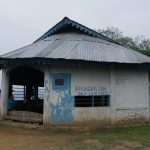 We drove for about 45 minutes and walked for about ten minutes to reach the Angh’s house to meet the king and a dozen of elders. The king is 84 years old. They were sitting around a fire. This house was also the dormitory for unmarried men of the tribal in the old days.
We drove for about 45 minutes and walked for about ten minutes to reach the Angh’s house to meet the king and a dozen of elders. The king is 84 years old. They were sitting around a fire. This house was also the dormitory for unmarried men of the tribal in the old days.
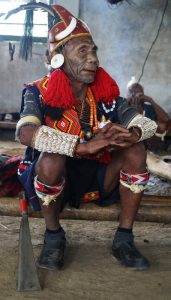 The men were all dressed in tribal clothing. They have a hat with a hornbill feather and tattoo on their face. The king and few leaders also have an ivory band on their arm and a blue-beaded band below the knee: these ornaments signify their senior position.
The men were all dressed in tribal clothing. They have a hat with a hornbill feather and tattoo on their face. The king and few leaders also have an ivory band on their arm and a blue-beaded band below the knee: these ornaments signify their senior position.
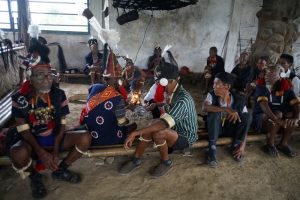 A group of elders the drum while we took photos with the king. Before leaving, we gave the king some money as a token of appreciation. He and the elders countered the money and seemed very pleased with our gift. The king took the lead to sing and they followed the drum beat and moved in a circle. Fantastic!
A group of elders the drum while we took photos with the king. Before leaving, we gave the king some money as a token of appreciation. He and the elders countered the money and seemed very pleased with our gift. The king took the lead to sing and they followed the drum beat and moved in a circle. Fantastic!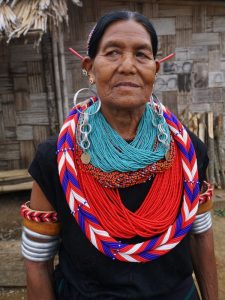
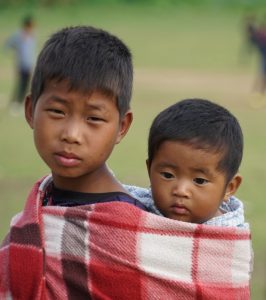 Then we walked through the village which looks surprisingly tidy without little litter. I met a lady who is 82: she looked much younger with smooth skin. But I was annoyed when a few children asking us for money. They have been corrupted!
Then we walked through the village which looks surprisingly tidy without little litter. I met a lady who is 82: she looked much younger with smooth skin. But I was annoyed when a few children asking us for money. They have been corrupted!
Day 11 Wednesday: Visit Longwa Village (64km)
The local guide arranged a morning visit to the Longwa Village located on the India-Myanmar border. The drive took almost two hours. The landscape is breath-taking with lush green mountains and a mosaic of patches of land cleared for cultivation. This was the most scenic ride of the entire trip.
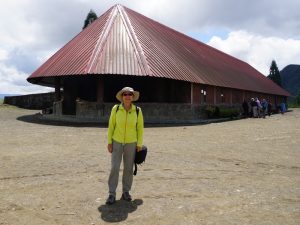 The Angh’s house is located on the ridge which forms the border between India and Myanmar. Half of the house falls within Indian Territory, whereas the other half lies under Myanmar’s control. The Angh (hereditary king) and the village council chairman control the whole village, and the Angh’s jurisdiction extends up to Myanmar and Arunchal Pradesh.
The Angh’s house is located on the ridge which forms the border between India and Myanmar. Half of the house falls within Indian Territory, whereas the other half lies under Myanmar’s control. The Angh (hereditary king) and the village council chairman control the whole village, and the Angh’s jurisdiction extends up to Myanmar and Arunchal Pradesh.
We first went to the Angh’s house. But the 42-year-old king was away as he had to attend the funeral of a wife of the council chairman who passed away the night before. As a result, the village celebration in the morning as part of the Aoleang Festival was also cancelled. It’s a pity.
The house is fairly new and well-built. We met the king’s uncle in the kitchen and watched him preparing opium over the fire. He mixed the stuff with tobacco before inhaling it. Opium smoking among men is still common in this region.
I stepped on the Myanmar soil. I visited it once in early 1990s and love to return one day. Then we took the same route back to Mon for the Aoleang Festival celebrations.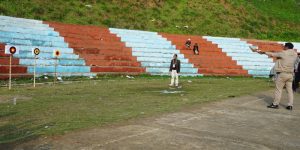
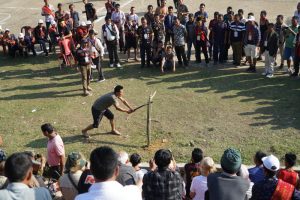 When we arrived at the sportsground, we discovered the morning celebrations with dance and music were over. Some members were disappointed and frustrated as they had not seen any cultural activity in Longwa Village and had expected some music and dance performances in Mon in the afternoon. They believed Navin and the local guide should have found out the main programme in Mon and Longwa Village before finalising the programme of the day.
When we arrived at the sportsground, we discovered the morning celebrations with dance and music were over. Some members were disappointed and frustrated as they had not seen any cultural activity in Longwa Village and had expected some music and dance performances in Mon in the afternoon. They believed Navin and the local guide should have found out the main programme in Mon and Longwa Village before finalising the programme of the day.
Anyway, the local guide said there would be festive activity in the sportsground in the afternoon. Lesley and I decided to go to walk to the town centre and had a grilled fish and red rice for lunch.
When we returned to the sportsground, the afternoon activity several competitions involving a show of masculinity and force had begun with tug of war. The next game was cutting a bunch of bamboo with an axe. But one man cut his leg by accident and was rushed to hospital.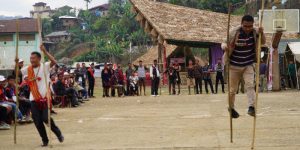
Then a dozen competitors took part in archery. I was surprised to find most of participants were not skilful: only one man hit the centre.
The final game was stilts walking. The winner turned out to the same guy who won the archery competition.
When the games were over, Claire and I had a go at the bow and arrow. Though I did not hit the centre, my arrow landed nicely on the board. Not too bad for a novice.
It was early when we returned to the homestay. I strolled around the village and discovered the houses nearby are all tidy and clean with nice gardens.
Day 12 Thursday: Aoleang Festival, Mon – Dibrugarh (175km)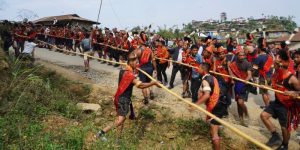
The Aoleang Festival marking the end of the current year and welcoming the arrival of spring, is held every year during the first week of April. It is time to pray for a bountiful harvest of crops in the coming year. The festival is celebrated with much pomp and fervour. Each day of the festival has its own significance, custom rituals and merry making. It also showcases the rich cultural heritage with indigenous dances, songs and games combined with the modern music talents of the district.
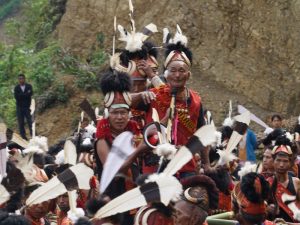 This year’s celebrations are held from April 1 to 6. When Exodus was planning this trip last year, it set aside two days for the festival with departure from Mon after the main celebration held on April 4. But the organiser subsequently decided to set a Guinness World Record by staging the largest traditional Konyak dance on April 5 involving 5,000 Konyak women in traditional attire and dancing to a ceremonial song for five minutes. I later watched the video and learnt that 4,000 ladies eventually participating in this spectacular event.
This year’s celebrations are held from April 1 to 6. When Exodus was planning this trip last year, it set aside two days for the festival with departure from Mon after the main celebration held on April 4. But the organiser subsequently decided to set a Guinness World Record by staging the largest traditional Konyak dance on April 5 involving 5,000 Konyak women in traditional attire and dancing to a ceremonial song for five minutes. I later watched the video and learnt that 4,000 ladies eventually participating in this spectacular event.
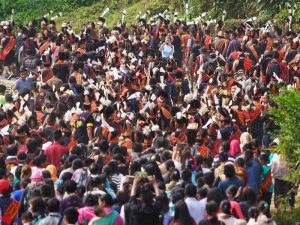
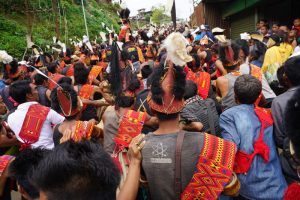 The local guide and Navin had carefully checked the programme to ensure we would not miss anything. After breakfast, we were dropped off at the point where the procession involving the pulling of a long drum by a few hundred men. The procession began around 5 am and the group would arrive at the sportsground around 11 am.
The local guide and Navin had carefully checked the programme to ensure we would not miss anything. After breakfast, we were dropped off at the point where the procession involving the pulling of a long drum by a few hundred men. The procession began around 5 am and the group would arrive at the sportsground around 11 am.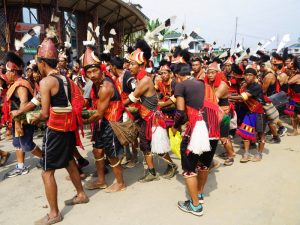
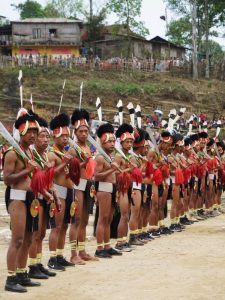 I watched and followed the procession for three hours. Men were all wearing traditional dresses and headgears decorated with feathers and wild boar tusks. They were pulling a long log drum (which must be over 10m long and chanting folk songs. They stopped many times to catch breath and rest.
I watched and followed the procession for three hours. Men were all wearing traditional dresses and headgears decorated with feathers and wild boar tusks. They were pulling a long log drum (which must be over 10m long and chanting folk songs. They stopped many times to catch breath and rest.
Hundreds of Konyak men in their own indigenous attires lined up to receive the main guests. One group of men looked almost naked!
When the guests were seated, the log drum made a grand entrance and was placed in front of the guest stand. As usual, there were several long boring speeches. Luckily, after each speech there was a performance of the log drum or dance.
I enjoyed the festive and informal atmosphere. There might be 30 overseas tourists and many more Indian tourists. We were allowed to move freely and many tourists got really close to the performers to take photos.
We left Mon around 1 pm before the end of the morning programme. Anyway, the dance and music became repetitive after a while. We had to drive back to Dibrugarh, Assam to take a plane to Kolkata the following day.
Dibrugarh, known as the ‘Camelia’ town of Assam, with its rich tea gardens resembling a lush green carpet, is also known as the gateway to the ‘Hidden Land’ of eastern Arunchal Pradesh.
It was an uneventful long drive. We only had a photo stop of a tea plantation by the road side and a toilet stop. Shortly after 5 pm, it got dark and we did not see much of Dibrugarh.
We arrived at Hotel Tea County, a nice business hotel before 7 pm. Security was tight as the Chairman of the ruling party BJP was on a campaign trail and would be staying in the same hotel that evening. We were tired and rushed to have dinner at the restaurant. I had a nice chicken biryani.



